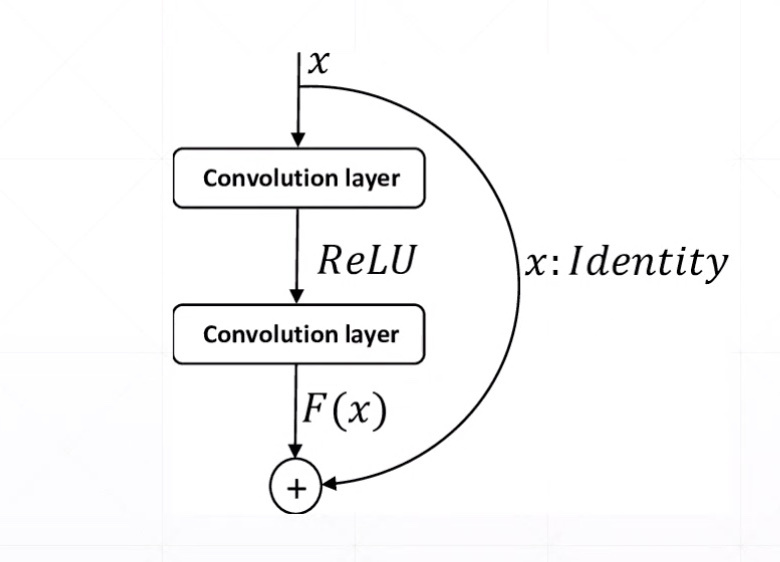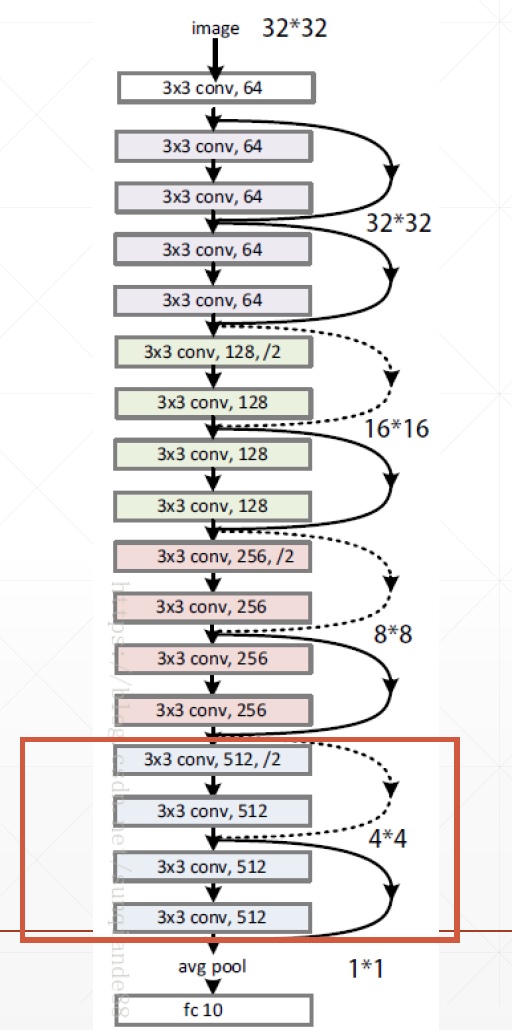ResNet实战

# Resnet.py
#!/usr/bin/env python
# -*- coding:utf-8 -*-
import tensorflow as tf
from tensorflow import keras
from tensorflow.keras import layers, Sequential
class BasicBlock(layers.Layer):
def __init__(self, filter_num, stride=1):
super(BasicBlock, self).__init__()
self.conv1 = layers.Conv2D(filter_num, (3, 3), strides=stride, padding='same')
self.bn1 = layers.BatchNormalization()
self.relu = layers.Activation('relu')
self.conv2 = layers.Conv2D(filter_num, (3, 3), strides=1, padding='same')
self.bn2 = layers.BatchNormalization()
if stride != 1:
self.downsample = Sequential()
self.downsample.add(layers.Conv2D(filter_num, (1, 1), strides=stride))
else:
self.downsample = lambda x: x
def call(self, inputs, training=None):
# [b,h,w,c]
out = self.conv1(inputs)
out = self.bn1(out)
out = self.relu(out)
out = self.conv2(out)
out = self.bn2(out)
identity = self.downsample(inputs)
output = layers.add([out, identity])
output = tf.nn.relu(output)
return out
Res Block

ResNet18

# Resnet.py
#!/usr/bin/env python
# -*- coding:utf-8 -*-
import tensorflow as tf
from tensorflow import keras
from tensorflow.keras import layers, Sequential
class BasicBlock(layers.Layer):
def __init__(self, filter_num, stride=1):
super(BasicBlock, self).__init__()
self.conv1 = layers.Conv2D(filter_num, (3, 3), strides=stride, padding='same')
self.bn1 = layers.BatchNormalization()
self.relu = layers.Activation('relu')
self.conv2 = layers.Conv2D(filter_num, (3, 3), strides=1, padding='same')
self.bn2 = layers.BatchNormalization()
if stride != 1:
self.downsample = Sequential()
self.downsample.add(layers.Conv2D(filter_num, (1, 1), strides=stride))
else:
self.downsample = lambda x: x
def call(self, inputs, training=None):
# [b,h,w,c]
out = self.conv1(inputs)
out = self.bn1(out)
out = self.relu(out)
out = self.conv2(out)
out = self.bn2(out)
identity = self.downsample(inputs)
output = layers.add([out, identity])
output = tf.nn.relu(output)
return out
class ResNet(keras.Model):
def __init__(self, layer_dims, num_classes=100): # [2,2,2,2]
super(ResNet, self).__init__()
# 根部
self.stem = Sequential([layers.Conv2D(64, (3, 3), strides=(1, 1,)),
layers.BatchNormalization(),
layers.Activation('relu'),
layers.MaxPool2D(pool_size=(2, 2), strides=(1, 1), padding='same')
])
# 64,128,256,512是通道数
self.layer1 = self.build_resblock(64, layer_dims[0])
self.layer2 = self.build_resblock(128, layer_dims[1], stride=2)
self.layer3 = self.build_resblock(256, layer_dims[2], stride=2)
self.layer4 = self.build_resblock(512, layer_dims[3], stride=2)
# output: [b, 512, h, w]
self.avgpool = layers.GlobalAveragePooling2D()
self.fc = layers.Dense(num_classes) # 分类
def call(self, inputs, training=None):
x = self.stem(inputs)
x = self.layer1(x)
x = self.layer2(x)
x = self.layer3(x)
x = self.layer4(x)
# [b, c]
x = self.avgpool(x)
# [b]
x = self.fc(x)
return x
def build_resblock(self, filter_num, blocks, stride=1):
res_blocks = Sequential()
# may down sample
res_blocks.add(BasicBlock(filter_num, stride))
for _ in range(1, blocks):
res_blocks.add(BasicBlock(filter_num, stride=1))
return res_blocks
def resnet18():
return ResNet([2, 2, 2, 2])
def resnet34():
return ResNet([3, 4, 6, 3])
# resnet18_train.py
#!/usr/bin/env python
# -*- coding:utf-8 -*-
import tensorflow as tf
from tensorflow.keras import layers, optimizers, datasets, Sequential
import os
from Resnet import resnet18
os.environ['TF_CPP_MIN_LOG_LEVEL'] = '2'
tf.random.set_seed(2345)
def preprocess(x, y):
# [-1~1]
x = tf.cast(x, dtype=tf.float32) / 255. - 0.5
y = tf.cast(y, dtype=tf.int32)
return x, y
(x, y), (x_test, y_test) = datasets.cifar100.load_data()
y = tf.squeeze(y, axis=1)
y_test = tf.squeeze(y_test, axis=1)
print(x.shape, y.shape, x_test.shape, y_test.shape)
train_db = tf.data.Dataset.from_tensor_slices((x, y))
train_db = train_db.shuffle(1000).map(preprocess).batch(512)
test_db = tf.data.Dataset.from_tensor_slices((x_test, y_test))
test_db = test_db.map(preprocess).batch(512)
sample = next(iter(train_db))
print('sample:', sample[0].shape, sample[1].shape,
tf.reduce_min(sample[0]), tf.reduce_max(sample[0]))
def main():
# [b, 32, 32, 3] => [b, 1, 1, 512]
model = resnet18()
model.build(input_shape=(None, 32, 32, 3))
model.summary()
optimizer = optimizers.Adam(lr=1e-3)
for epoch in range(500):
for step, (x, y) in enumerate(train_db):
with tf.GradientTape() as tape:
# [b, 32, 32, 3] => [b, 100]
logits = model(x)
# [b] => [b, 100]
y_onehot = tf.one_hot(y, depth=100)
# compute loss
loss = tf.losses.categorical_crossentropy(y_onehot, logits, from_logits=True)
loss = tf.reduce_mean(loss)
grads = tape.gradient(loss, model.trainable_variables)
optimizer.apply_gradients(zip(grads, model.trainable_variables))
if step % 50 == 0:
print(epoch, step, 'loss:', float(loss))
total_num = 0
total_correct = 0
for x, y in test_db:
logits = model(x)
prob = tf.nn.softmax(logits, axis=1)
pred = tf.argmax(prob, axis=1)
pred = tf.cast(pred, dtype=tf.int32)
correct = tf.cast(tf.equal(pred, y), dtype=tf.int32)
correct = tf.reduce_sum(correct)
total_num += x.shape[0]
total_correct += int(correct)
acc = total_correct / total_num
print(epoch, 'acc:', acc)
if __name__ == '__main__':
main()
(50000, 32, 32, 3) (50000,) (10000, 32, 32, 3) (10000,)
sample: (512, 32, 32, 3) (512,) tf.Tensor(-0.5, shape=(), dtype=float32) tf.Tensor(0.5, shape=(), dtype=float32)
Model: "res_net"
_________________________________________________________________
Layer (type) Output Shape Param #
=================================================================
sequential (Sequential) multiple 2048
_________________________________________________________________
sequential_1 (Sequential) multiple 148736
_________________________________________________________________
sequential_2 (Sequential) multiple 526976
_________________________________________________________________
sequential_4 (Sequential) multiple 2102528
_________________________________________________________________
sequential_6 (Sequential) multiple 8399360
_________________________________________________________________
global_average_pooling2d (Gl multiple 0
_________________________________________________________________
dense (Dense) multiple 51300
=================================================================
Total params: 11,230,948
Trainable params: 11,223,140
Non-trainable params: 7,808
_________________________________________________________________
WARNING: Logging before flag parsing goes to stderr.
W0601 16:59:57.619546 4664264128 optimizer_v2.py:928] Gradients does not exist for variables ['sequential_2/basic_block_2/sequential_3/conv2d_7/kernel:0', 'sequential_2/basic_block_2/sequential_3/conv2d_7/bias:0', 'sequential_4/basic_block_4/sequential_5/conv2d_12/kernel:0', 'sequential_4/basic_block_4/sequential_5/conv2d_12/bias:0', 'sequential_6/basic_block_6/sequential_7/conv2d_17/kernel:0', 'sequential_6/basic_block_6/sequential_7/conv2d_17/bias:0'] when minimizing the loss.
0 0 loss: 4.60512638092041
Out of memory
- decrease batch size
- tune resnet[2,2,2,2]
- try Google CoLab
- buy new NVIDIA GPU Card
ResNet实战的更多相关文章
- TensorFlow2教程(目录)
第一篇 基本操作 01 Tensor数据类型 02 创建Tensor 03 Tensor索引和切片 04 维度变换 05 Broadcasting 06 数学运算 07 前向传播(张量)- 实战 第二 ...
- Pytorch1.0入门实战三:ResNet实现cifar-10分类,利用visdom可视化训练过程
人的理想志向往往和他的能力成正比. —— 约翰逊 最近一直在使用pytorch深度学习框架,很想用pytorch搞点事情出来,但是框架中一些基本的原理得懂!本次,利用pytorch实现ResNet神经 ...
- Pytorch1.0入门实战二:LeNet、AleNet、VGG、GoogLeNet、ResNet模型详解
LeNet 1998年,LeCun提出了第一个真正的卷积神经网络,也是整个神经网络的开山之作,称为LeNet,现在主要指的是LeNet5或LeNet-5,如图1.1所示.它的主要特征是将卷积层和下采样 ...
- [深度应用]·实战掌握PyTorch图片分类简明教程
[深度应用]·实战掌握PyTorch图片分类简明教程 个人网站--> http://www.yansongsong.cn/ 项目GitHub地址--> https://github.com ...
- 学习笔记TF033:实现ResNet
ResNet(Residual Neural Network),微软研究院 Kaiming He等4名华人提出.通过Residual Unit训练152层深神经网络,ILSVRC 2015比赛冠军,3 ...
- Reading | 《TensorFlow:实战Google深度学习框架》
目录 三.TensorFlow入门 1. TensorFlow计算模型--计算图 I. 计算图的概念 II. 计算图的使用 2.TensorFlow数据类型--张量 I. 张量的概念 II. 张量的使 ...
- 人工智能深度学习框架MXNet实战:深度神经网络的交通标志识别训练
人工智能深度学习框架MXNet实战:深度神经网络的交通标志识别训练 MXNet 是一个轻量级.可移植.灵活的分布式深度学习框架,2017 年 1 月 23 日,该项目进入 Apache 基金会,成为 ...
- 【深度学习】基于Pytorch的ResNet实现
目录 1. ResNet理论 2. pytorch实现 2.1 基础卷积 2.2 模块 2.3 使用ResNet模块进行迁移学习 1. ResNet理论 论文:https://arxiv.org/pd ...
- tensorflow学习笔记——ResNet
自2012年AlexNet提出以来,图像分类.目标检测等一系列领域都被卷积神经网络CNN统治着.接下来的时间里,人们不断设计新的深度学习网络模型来获得更好的训练效果.一般而言,许多网络结构的改进(例如 ...
随机推荐
- nc的基本用法
nc(netcat) 被誉为网络安全界的‘瑞士军刀’,可以用于完成几乎涉及TCP.UDP或者Unix域套接字的任何事.它可以打开TCP连接,发送UDP报文,在任意的TCP和UDP端口监听,进行端口扫描 ...
- Taro 采坑日常
组件事件传参只能在类作用域下的确切引用(this.handleXX || this.props.handleXX),或使用 bind. 组件中点击事件如下 // 组件 <AtListItem k ...
- 51nod 1154 回文串划分
1154 回文串划分 基准时间限制:1 秒 空间限制:131072 KB 分值: 40 难度:4级算法题 收藏 关注 有一个字符串S,求S最少可以被划分为多少个回文串. 例如:abbaabaa,有 ...
- 用.NetReactor保护您的源码[转][修改]
原文链接 前言 VS开发的源代码安全性,是很多开发者头痛的事情.于是保护好源代码便成了开发者们最关心的事情之一了. 在网上搜一搜,很多有不少的第三方工具可以为源代码加密.加密方式不外乎就是混淆,加壳. ...
- 203 Remove Linked List Elements 删除链表中的元素
删除链表中等于给定值 val 的所有元素.示例给定: 1 --> 2 --> 6 --> 3 --> 4 --> 5 --> 6, val = 6返回: 1 --& ...
- C#特性的介绍及应用场景
1.特性的任务:特性就是为了支持对象添加一些自我描述的信息,不影响类封装的前提添加额外信息.如果你用这个信息,那特性就有用:如果你不需要这个信息,那么这个特性就没用. 2.特性的基类:Attribut ...
- JDK集合框架--综述
接下来的几篇博客总结一下对jdk中常用集合类知识,本篇博客先整体性地介绍一下集合及其主要的api: 从整体上来说,集合分两大类collection和map: 首先来看看Collection: c ...
- LN : leetcode 70 Climbing Stairs
lc 70 Climbing Stairs 70 Climbing Stairs You are climbing a stair case. It takes n steps to reach to ...
- 安装JPype时出现的 Unable to find vcvarsall.bat
解决方案,在网上找到的,mark一下,亲测有效 C:/Python31/Lib/distutils目录下的msvc9compiler.py中 修改MSVCCompiler函数:vc_env = que ...
- ibatis 的sqlMap 的xml 关注点
1.当有特殊字符时候需要保持原状 eg:特殊字符 <> 错误:t.name<>' ' 会报The content of elements must consist of ...
